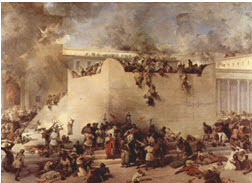What is the Jewish Commemoration of Tisha B'AV?

Tisha B'Av literally means "the ninth (day) of Av, and is the annual Fast of the Ninth of Av. It occurs during August or late July. In 2015, it occurs Sunday, July 26 and 27.
It is a day of mourning to commemorate the many tragedies that have befallen the Jewish people, many of which coincidentally occurred on the ninth of Av.
Tisha B'Av primarily commemorates the destruction of the first and second Temples, both destroyed on the ninth of Av (the first by the Babylonians in 423 B.C., the second by the Romans in A.D. 69. This holiday also commemorates the subsequent exile of the Jews from the Land of Israel.
The Fast of Tishah B'Av is a mourning fast
For approximately 25 hours - from sundown on Saturday to nightfall Sunday evening - observers abstain from eating and drinking, bathing, the wearing of leather footwear, and marital relations. It is customary to sit on the floor or a low seat until after mid-day. Torah study is restricted to laws of mourning, passages describing the destruction of the Temple, and the like. Eicha (the book of Lamentations) is read with a unique nusah, a special melody. The tefillin (phylacteries) are worn only during the afternoon prayers. Observation is more stringent than Yom Kippur prohibitions.
How is this holiday significant to the Latter-day Saints?
About thirty-seven years before the destruction, Jesus had foretold the terrible events that would follow his death. He warned his followers to immediately flee Jerusalem when the signs he predicted occurred. The Christian community carefully watched for the signs and followed the Savior's warning.
The Lord first identified the situation leading up to destruction: Many would deceive the people by saying that they were prophets or even Christ himself. The disciples would be delivered up and afflicted, hated of all nations. Betrayal and iniquity would abound, and the love of many would turn cold. (See Matt. 24:10-12; JST-M 1:6-10.) The Lord then taught of two major signs that would alert believers to flee: "When ye shall see Jerusalem compassed with armies, then know that the desolation thereof is nigh." (Luke 21:20.)
He also said, "When ye therefore shall see the abomination of desolation, spoken of by Daniel the prophet, stand in the holy place, (whoso readeth, let him understand:) "Then let them which be in Judaea flee into the mountains..."
"Whoso treasureth up my word, shall not be deceived" (JS-M 1:37), the Lord says. He urges us to stand in holy places, as President Ezra Taft Benson has told us, that "include our temples, our chapels, our homes, and the stakes of Zion." These are, as the Lord declares, "for a defense, and for a refuge from the storm, and from wrath when it shall be poured out without mixture upon the whole earth." (D&C 115:6.) We must be aware of the sign of the times and be ready when tragedy occurs. The temples on the earth today are the houses of the Lord Jesus Christ.
In the Book of Mormon, the righteous followers of God were led to build and worship in temples (2 Ne. 5:16; Mosiah 1:18; 3 Ne. 11:1). Building and using a temple properly are signs of the true Church in any dispensation, including the restored Church in our day. The Kirtland Temple was the first temple built and dedicated to the Lord in this dispensation. Since that time temples have been dedicated in many lands across the earth.
- Who shall stand in his holy place?: Ps. 24:3-5
- Let us go up to the house of the God of Jacob: Isa. 2:2-3 ( Micah 4:1-2 2 Ne. 12:2-3 )
- The Lord shall suddenly come to his temple: Mal. 3:1 ( 3 Ne. 24:1 D&C 36:8 D&C 42:36 )
- Jesus cleansed the temple: Matt. 21:12-16 ( Mark 11:15-18 Luke 19:45-48 )
- The saints were commanded to build a temple in Missouri: D&C 57:3 ( D&C 84:3-5 )
- Establish a house of God: D&C 88:119 ( D&C 109:8 )
- The Lord chastened the Saints for failing to build a temple: D&C 95:1-12
- I will not come into unholy temples: D&C 97:15-17
- I have accepted this house, and my name shall be here: D&C 110:7-8
- The Lord's people are always commanded to build a house unto his name: D&C 124:39
- The great work to be done in the temples includes the sealing of children to their parents: D&C 138:47-48
- The great latter-day work includes the building of temples: D&C 138:53-54
This Organization has no affiliation with the Church, does not represent the Church, receives no support from the Church, is not sanctioned by the Church in any way; therefore, its actions cannot be attributed to the Church.
No Officer, Director, or member shall proselytize or act in any way that may be construed as having the purpose of proselytizing of descendants of Abraham in the State of Israel.